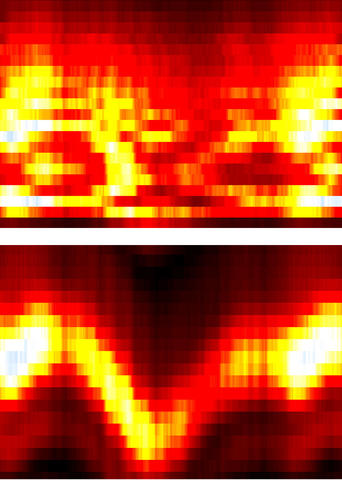
Conventional laser ranging systems would fail to produce usable data on the range to a target about 1 kilometer away (false color image, top). By contrast, the NIST system obtains a clear image of the relative changes in the range to the target with time. The rise and fall of the plot (bottom) represents very small changes in range from the detector to the surface of a rotating, wobbling disk.
Scientists at the National Institute of Standards and Technology (NIST) have demonstrated the use of an ultrafast laser "frequency comb" system for improved remote measurements of distance and vibration. The technology, described in a forthcoming issue of Optics Letters, may have applications in automated manufacturing or defense systems because it enables unusually precise characterization of the range profile and motion of a surface.
The NIST laboratory system is an adaptation of light detection and ranging (LIDAR), which transmits light through the air to a target and analyzes the weak reflected signal to measure the distance, or range, to the target and other parameters. The NIST system uses an infrared laser that emits a continuous train of very brief, closely spaced pulses of light of many colors, or frequencies. An analysis of the frequencies reveals a very fine "comb" of evenly spaced teeth. The short pulse length (quadrillionths of a second, or millionths of a billionth of a second) creates a wide range of comb frequencies, enabling more accurate range measurements; the inherent stability of the laser creates fine comb teeth, enabling very precise vibration measurements.
The frequency comb serves as both the light source and as a precise ruler for measuring the reflected signal. NIST-developed software analyzes the intensity of the reflected signal to measure distance to the target, and analyzes the frequency (or Doppler) shift to measure vibration. The most unusual aspect of the system is the way it resolves common problems with signal "noise" and dispersion of light by the atmosphere into longer pulses (with different colors of light traveling at different speeds). The reflected light that is detected is divided into a number of different color bands for computer processing. Measurements are averaged across the channels, effectively multiplying the precision of the result by the number of channels.
The system was used to determine the distance to, and vibration of, a rotating disk located on the far side of the laboratory. Experiments were conducted under a variety of conditions. For example, with the reflected light transmitted over an extended distance (partly through 1 kilometer of optical fiber wrapped around a spool), the NIST system could measure a 45-micrometer displacement across the disk surface at a range of 1 km thanks to the signal processing method. Conventional LIDAR would have failed at that distance due to dispersion of the reflected light within the fiber, according to the paper.
W.C. Swann and N.R. Newbury. 2006. Frequency-resolved coherent LIDAR using a femtosecond fiber laser. Optics Letters. Scheduled for the March 15 issue. Posted online Nov. 23, 2005.

